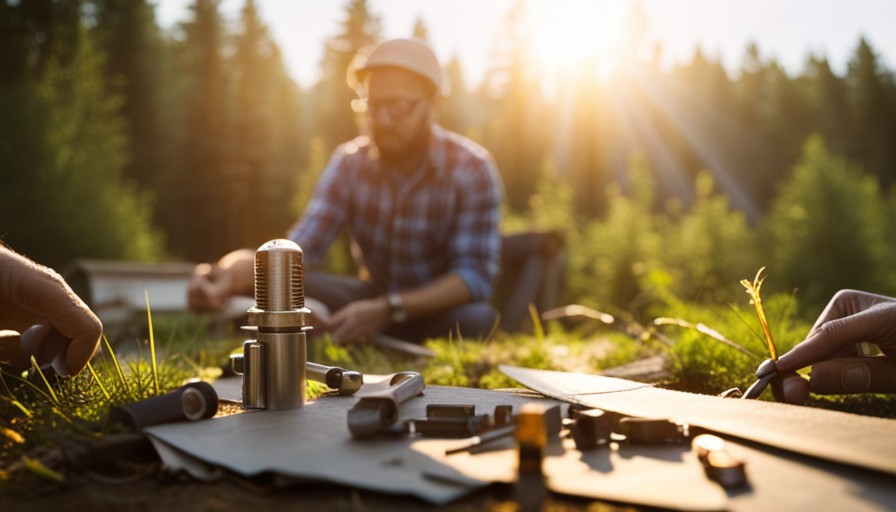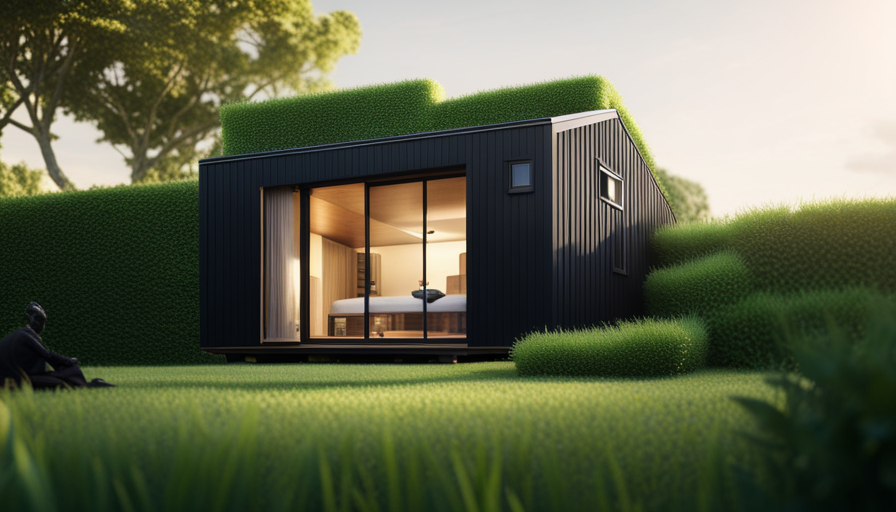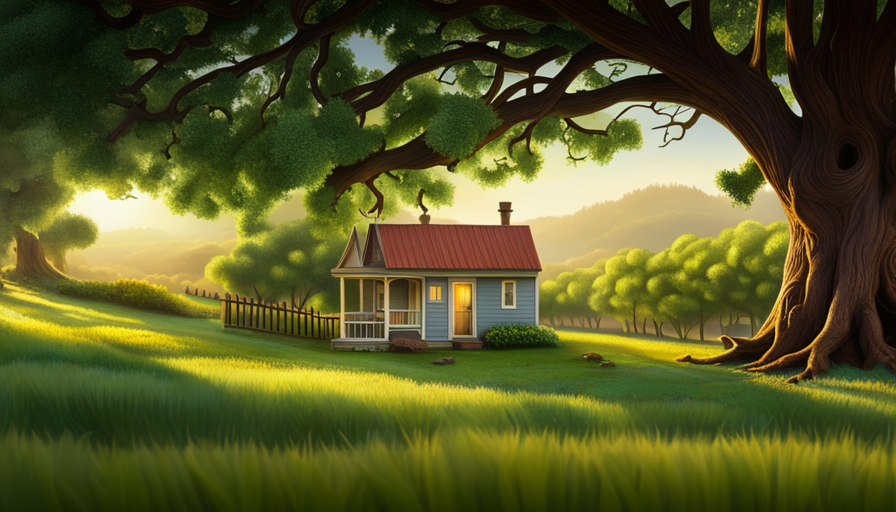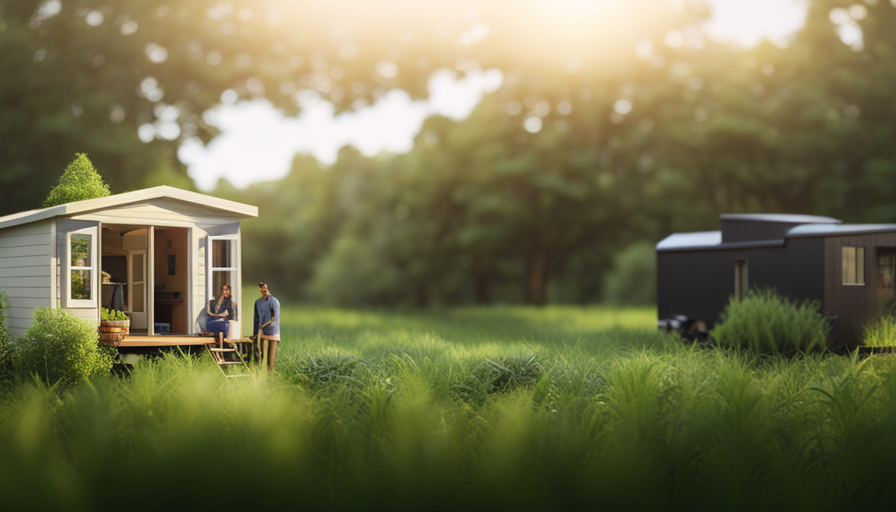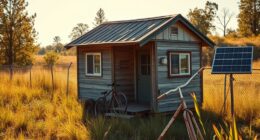Imagine waking up at sunrise to the sound of birds singing, surrounded by the peacefulness of nature and the simple joys of life. Now, envision having this experience in a home no larger than a typical living room. This is the daily reality for those living in tiny homes.
I first became intrigued by the concept of tiny houses when I stumbled upon the story of Sarah, a single mother who decided to downsize her life and build her own tiny house. With limited resources and a desire for financial freedom, she embarked on a journey that would forever change her life.
A tiny house, as the name suggests, is a compact dwelling that typically ranges from 100 to 400 square feet. It is a minimalist approach to living, where every square inch is utilized efficiently. These houses are built on a foundation or can be mounted on a trailer for mobility.
In this article, we will explore the definition and characteristics of a tiny house, the benefits of living in one, the different types available, design considerations, challenges, and tips for building or buying a tiny house. We will also delve into personal stories and experiences of tiny house owners, as well as provide resources and communities for those who are passionate about the tiny house movement.
So, let’s embark on this journey and discover the world of tiny houses together.
Key Takeaways
- Tiny houses are compact dwellings that range from 100 to 400 square feet and can be built on a foundation or mounted on a trailer.
- They offer financial benefits such as lower construction costs, utility bills, and property taxes, but also come with challenges like limited space, lack of privacy, and storage.
- Tiny houses maximize efficiency with clever storage solutions and multi-purpose furniture, and provide financial freedom, minimal environmental impact, and a simpler lifestyle.
- There are different types of tiny houses including houses on wheels, converted shipping containers, and small prefabricated homes, each with their own unique benefits and considerations.
Definition and Characteristics of a Tiny House
If you’re looking for a compact and minimalist living space, a tiny house is the perfect choice for you. A tiny house is a small dwelling, typically less than 400 square feet, that is designed to maximize space and minimize material possessions. These homes are built on a trailer or a foundation, and they offer a range of benefits and drawbacks.
One of the biggest advantages of a tiny house is the financial considerations. These homes are significantly cheaper to build and maintain compared to traditional houses. The reduced size means lower construction costs, lower utility bills, and lower property taxes. Additionally, because of their mobility, tiny houses can be placed on cheaper land or even rented out as vacation homes, providing additional income opportunities.
However, living in a tiny house also comes with its drawbacks. The limited space can be challenging, especially for individuals or families with a lot of belongings. Additionally, the lack of privacy and storage space can be a concern. It requires careful organization and minimalism to make the most of the available space.
Despite these challenges, the benefits of living in a tiny house outweigh the drawbacks for many people. These include financial freedom, minimal environmental impact, and a simpler lifestyle.
In the next section, we will explore these benefits in more detail.
Benefits of Living in a Tiny House
Imagine the freedom and simplicity that comes with living in a small space, where every corner is carefully designed to maximize efficiency and minimize clutter. Living in a tiny house offers numerous benefits, making it an attractive option for those seeking a minimalist lifestyle.
One of the key advantages is the ability to maximize efficiency. Every inch of a tiny house is utilized to its fullest potential, with clever storage solutions and multi-purpose furniture. This means that you can have all the amenities you need in a compact space, without sacrificing comfort or functionality.
Financial savings are another significant benefit of living in a tiny house. The reduced size means lower construction and maintenance costs, as well as decreased utility bills. With fewer square feet to heat, cool, and light, you can save a substantial amount of money on energy expenses. Additionally, the lower overall cost of a tiny house means that it is more affordable to purchase or build, allowing you to achieve homeownership without a massive mortgage.
Transitioning into the subsequent section about different types of tiny houses, it is important to understand that there are various styles and designs to suit different preferences and needs.
Different Types of Tiny Houses
When it comes to tiny houses, there are several different types to consider.
One option is tiny houses on wheels, which are built on a trailer for easy mobility.
Another option is converted shipping containers, where old containers are repurposed into livable spaces.
Lastly, there are small prefabricated homes, which are pre-built in a factory and then transported to the desired location.
Each type of tiny house offers its own unique advantages and considerations, making it important to choose the right one for your needs.
Tiny Houses on Wheels
To fully experience the freedom and versatility of tiny houses on wheels, you can customize your living space to fit your unique needs and travel to your heart’s content.
Here are the benefits of mobility that come with tiny houses on wheels:
-
Flexibility: With a tiny house on wheels, you have the flexibility to change your location whenever you desire. You can easily move your home to a new city or even a different country.
-
Cost savings: By living in a tiny house on wheels, you can avoid the high costs of a traditional home. You don’t have to pay property taxes or a mortgage, and you can save money on utilities and maintenance.
-
Minimal environmental impact: Tiny houses on wheels are often designed to be eco-friendly, using sustainable materials and renewable energy sources. Additionally, their small size reduces energy consumption and waste.
-
Adventure and exploration: With a tiny house on wheels, you have the freedom to explore new places and experience different cultures. You can travel to remote locations and enjoy the beauty of nature.
Transitioning to the subsequent section about ‘converted shipping containers’, let’s explore another unique way to create a tiny living space.
Converted Shipping Containers
With their industrial charm and endless possibilities, converted shipping containers offer a creative and unconventional solution for those seeking a unique living space. These repurposed containers provide several advantages, such as affordability, sustainability, and mobility. However, they also come with their own set of challenges. The limited size of the container requires careful planning and efficient use of space to ensure a comfortable living environment. Additionally, insulation and ventilation can be problematic, requiring extra attention to maintain suitable temperature and air quality. Despite these challenges, the ability to customize and transform a shipping container into a home allows for personalized design choices and a one-of-a-kind living experience. As we transition into the next section about small prefabricated homes, it is important to note that while shipping containers offer a unique option, there are alternative solutions available for those seeking a compact and efficient living space.
Small Prefabricated Homes
Prefabricated homes offer a convenient and stylish alternative for those in search of a compact living space. These small modular homes are designed with eco-friendly construction methods, making them not only space-efficient but also environmentally conscious.
Here are three reasons why small prefabricated homes are gaining popularity:
-
Energy Efficiency: These homes are built with energy-saving features such as high-quality insulation and energy-efficient appliances, reducing the carbon footprint and lowering utility bills.
-
Customization Options: Despite their compact size, small prefabricated homes offer a range of customization options. Homeowners can personalize their living space to suit their taste and needs, from choosing the layout to selecting finishes and fixtures.
-
Cost-Effectiveness: Prefabricated homes are often more affordable than traditional houses. They are factory-built, minimizing construction time and labor costs.
Considering design and layout considerations, it is essential to optimize every inch of space in a small prefabricated home while maintaining a comfortable and functional environment.
Design and Layout Considerations
When designing a tiny house, there are several key considerations to keep in mind to maximize space and storage solutions. By utilizing multifunctional furniture and smart design features, it’s possible to make the most of every inch of the living area.
Additionally, incorporating energy-efficient features won’t only reduce utility costs but also contribute to a sustainable and environmentally friendly living space.
Maximizing Space and Storage Solutions
In the world of tiny houses, space is a precious gem that must be carefully mined and utilized to create a cozy and efficient living environment. Maximizing space and finding creative storage solutions are essential in making the most of limited square footage.
One approach is to incorporate built-in furniture and storage units that serve dual purposes. For example, a staircase can double as a series of drawers, or a dining table can have hidden compartments for storing items.
Utilizing vertical space is also crucial. Installing wall-mounted shelves, hooks, and racks can help keep belongings organized and off the floor. Additionally, utilizing under-bed storage and incorporating foldable or collapsible furniture can further optimize space.
By implementing these strategies, tiny house dwellers can make their living space functional and comfortable, seamlessly transitioning into the subsequent section about multifunctional furniture and smart design.
Multifunctional Furniture and Smart Design
Maximizing space and storage solutions is only the beginning; multifunctional furniture and smart design take tiny living to a whole new level. In order to make the most of limited square footage, tiny houses often incorporate innovative space-saving techniques.
Multifunctional furniture plays a crucial role in maximizing functionality and optimizing space. Beds that can be folded into the wall during the day, transforming into a desk or seating area, are a common feature in tiny houses. Additionally, tables with built-in storage compartments and benches that double as storage units are popular choices.
Smart design is also key to maximizing space in tiny houses. This involves strategically placing windows to allow for natural light and ventilation, as well as utilizing vertical space with lofted sleeping areas or storage solutions.
With multifunctional furniture and smart design, tiny houses achieve a level of efficiency and practicality that is unparalleled in traditional homes. Transitioning into the subsequent section about energy-efficient features, these design choices also contribute to the overall sustainability and eco-friendliness of tiny houses.
Energy-Efficient Features
To truly transform your small living space, you’ll want to embrace energy-efficient features that not only save you money, but also create a cozy and sustainable environment. When it comes to energy-efficient design in tiny houses, every detail counts.
From insulation to lighting, there are various ways to minimize energy consumption. Insulating the walls, roof, and floor effectively prevents heat loss and reduces the need for heating or cooling. Additionally, using sustainable materials such as reclaimed wood or recycled insulation not only reduces environmental impact but also improves overall energy efficiency. Using energy-efficient appliances and LED lighting further decreases energy usage.
By incorporating these energy-saving features, you can create a comfortable and sustainable living space in your tiny house.
Transitioning into the subsequent section about challenges and considerations, it is important to address potential limitations and trade-offs in designing an energy-efficient tiny house.
Challenges and Considerations
When considering the challenges and considerations of living in a tiny house, there are several key points to keep in mind.
Firstly, zoning and legal restrictions can pose a significant hurdle, as many areas have regulations and codes that limit where tiny houses can be located.
Secondly, limited space and potential clutter are common issues, as the compact nature of tiny houses requires careful organization and minimal possessions.
Lastly, adjusting to a smaller lifestyle can be a significant adjustment, as it may require downsizing and reevaluating one’s needs and priorities.
Zoning and Legal Restrictions
Despite some legal restrictions, tiny houses have become increasingly popular due to their unique and efficient design. However, building a tiny house can pose challenges when it comes to zoning and legal restrictions.
Municipalities often have strict building codes that dictate the minimum square footage required for a dwelling. This can make it difficult to legally build a tiny house, as they often fall below the minimum square footage requirements. Additionally, some areas have specific zoning laws that prohibit or restrict the placement of tiny houses. These restrictions can limit where you can park or build your tiny house, making it important to research local regulations before embarking on your tiny house journey.
Understanding and navigating these zoning and legal restrictions is crucial for anyone considering the tiny house lifestyle. Transitioning into the next section, limited space and potential clutter can pose additional challenges in living in a tiny house.
Limited Space and Potential Clutter
Living in a tiny house means navigating the challenges of limited space and the potential for clutter. Maximizing storage is crucial in order to maintain a minimalist living environment. Every inch of the tiny house needs to be utilized efficiently to ensure that there is enough room for essential items.
This often requires creative solutions such as built-in storage compartments, multi-functional furniture, and utilizing vertical space. By carefully organizing belongings and adopting a minimalist mindset, it becomes possible to keep the house clutter-free. However, it’s important to acknowledge that living in a tiny house may require adjustments to a smaller lifestyle.
This means prioritizing needs over wants and being mindful of the space available. Transitioning to a smaller lifestyle can be challenging, but it offers the opportunity for a simpler and more intentional way of living.
Adjusting to a Smaller Lifestyle
Adapting to a smaller lifestyle may present challenges, but it offers the chance for a more intentional and simplified way of living. In a tiny house, maximizing minimalism becomes crucial, as every square inch counts. Downsizing essentials is a fundamental aspect of adjusting to this smaller lifestyle. It requires careful consideration of what items are truly necessary and what can be let go. It involves prioritizing functionality over excess and choosing multi-purpose furniture and storage solutions.
Living in a tiny house encourages a mindset shift towards conscious consumption and reducing waste. It requires thoughtful organization and creative use of space. Adjusting to this smaller lifestyle may take time, but it allows for a more intentional and deliberate way of living.
Transitioning into the subsequent section about tips for building or buying a tiny house, it is important to consider these aspects while planning for a tiny home.
Tips for Building or Buying a Tiny House
When it comes to building or buying a tiny house, you’ll want to envision your dream home in miniature form.
There are a few factors to consider when deciding between buying or building your tiny house.
Firstly, buying a tiny house might be more convenient if you don’t have the time or expertise to construct one yourself. There are many pre-built options on the market that can be customized to fit your needs. On the other hand, building your own tiny house allows for complete customization and the satisfaction of creating something from scratch.
Financing options are another important aspect to consider. If you choose to buy a tiny house, you may be able to secure a loan through a traditional lender or explore alternative financing options. Building a tiny house can be more cost-effective, but it requires upfront capital and may not be as easily financed through traditional means.
In terms of buying or building, it ultimately comes down to personal preference and circumstances.
Now, let’s delve into the personal stories and experiences of tiny house owners, where you’ll gain insight into the challenges and rewards of living in a tiny home.
Personal Stories and Experiences of Tiny House Owners
Immerse yourself in the captivating tales and firsthand accounts of those who’ve embraced the miniature lifestyle and discovered the joys and challenges of their pint-sized abodes.
As a tiny house owner, I’ve faced numerous personal challenges that come with living in a small space. One of the biggest challenges is the limited storage options. With minimal square footage, it becomes essential to maximize every inch of space and find creative storage solutions.
Living in a tiny house also requires careful financial considerations. While the initial cost of building or buying a tiny house may be lower than that of a traditional home, there are ongoing expenses to consider, such as land rental fees, utilities, and maintenance costs. However, many tiny house owners find that the financial freedom and reduced living expenses outweigh these challenges.
Transitioning into the subsequent section about resources and communities for tiny house enthusiasts, it’s crucial to tap into these networks to find support, inspiration, and advice on overcoming personal challenges and making informed financial decisions.
Resources and Communities for Tiny House Enthusiasts
When it comes to resources and communities for tiny house enthusiasts, there are several key points to consider.
First, online forums and blogs are a great way to connect with like-minded individuals and gather valuable information and advice.
Second, attending tiny house festivals and events not only provides the opportunity to see different types of tiny houses firsthand, but also allows for networking and learning from experts in the field.
Lastly, for those interested in a more communal living experience, there are tiny house communities and co-living spaces that offer a sense of community and shared resources.
Online Forums and Blogs
Explore the fascinating world of tiny houses through online forums and blogs, where you can dive into a treasure trove of captivating stories and visually stunning images. These online communities connect tiny house enthusiasts from all over the world, providing a platform to share ideas, ask questions, and gain inspiration for your own DIY projects.
Here are four reasons why these forums and blogs are a must-visit for anyone interested in the tiny house movement:
-
Endless Inspiration: Immerse yourself in a world of creativity and innovation as you browse through countless photos and videos of beautifully designed tiny homes.
-
Expert Advice: Tap into the collective knowledge of experienced builders and homeowners who are more than willing to share their wisdom and expertise.
-
Supportive Community: Connect with like-minded individuals who are passionate about living simply, sustainably, and efficiently in tiny spaces.
-
Problem Solving: Get answers to your burning questions and troubleshoot common challenges that arise during the construction and maintenance of your tiny home.
Now, let’s transition into the subsequent section about ‘tiny house festivals and events’ to further expand your understanding of the tiny house movement.
Tiny House Festivals and Events
By participating in tiny house festivals and events, individuals can gain valuable insights and connect with a community of like-minded enthusiasts, fostering a deeper appreciation for the movement’s principles of simplicity and sustainability. These festivals provide a platform for tiny house enthusiasts to showcase their innovative designs, exchange ideas, and learn from experts through workshops and seminars. Tiny house festivals often feature tours of different tiny house models, allowing attendees to see firsthand the creative solutions and efficient use of space. Additionally, these events offer an opportunity to network with builders, suppliers, and other individuals who share a passion for tiny living. Attending a tiny house festival or workshop can inspire individuals to embark on their own tiny house journey or refine their existing plans. Transitioning into the subsequent section about ‘tiny house communities and co-living spaces’, individuals can further explore the possibilities of living in a close-knit community while enjoying the benefits of a tiny house lifestyle.
Tiny House Communities and Co-living Spaces
Immerse yourself in a vibrant community of like-minded individuals, where neighbors become family and common spaces are a hub of activity, by joining a tiny house community or co-living space.
Tiny house communities and co-living spaces offer an affordable housing solution for those seeking a simpler and more sustainable lifestyle. These communities provide an opportunity to live in a small, energy-efficient home while enjoying the benefits of shared amenities and a strong sense of community.
It’s important to note that tiny house regulations vary from place to place, so it’s crucial to research and understand the local zoning laws and building codes before embarking on this lifestyle. However, many communities and co-living spaces have already navigated these regulations and offer a supportive environment for tiny house living.
Frequently Asked Questions
What are the legal requirements for living in a tiny house?
To live in a tiny house, I must comply with legal restrictions and zoning laws. These regulations vary by location, so it’s important to research and understand the specific requirements in my area.
How do tiny houses impact the environment?
Living in a tiny house offers environmental benefits and promotes sustainable living. It reduces energy consumption, minimizes waste, and encourages a simpler lifestyle. Tiny houses are an eco-friendly solution for those seeking to minimize their environmental impact.
Can you live in a tiny house with a family?
Living in a tiny house with a family can be challenging due to living space limitations. However, with careful planning and organization, it is possible to make it work. Practicality of tiny house living depends on individual preferences and lifestyle.
How do tiny houses handle utilities such as water and electricity?
Tiny house utilities, such as water and electricity, are handled differently in off-grid living. Water can be collected from rainwater harvesting systems and stored in tanks, while electricity is typically generated through solar panels and stored in batteries.
Are there any financing options available for purchasing a tiny house?
There are various financing options available for purchasing a tiny house, allowing individuals to explore alternative living options. These options include loans from specialized lenders, personal savings, crowdfunding, and even RV loans for mobile tiny homes.
Conclusion
In conclusion, living in a tiny house offers numerous benefits such as reduced environmental impact, lower cost of living, and increased freedom and simplicity.
It’s fascinating to note that according to a recent survey, 68% of tiny house owners don’t have a mortgage compared to only 29% of traditional homeowners. This statistic highlights the financial advantages of owning a tiny house and showcases the potential for financial freedom that comes with downsizing.
Whether you choose to build or buy, the tiny house lifestyle is worth considering for those seeking a more sustainable and minimalist way of living.
Hi, I’m Emma. I’m the Editor in Chief of Tiny House 43, a blog all about tiny houses. While tree houses are often associated with childhood, they can be the perfect adult retreat. They offer a cozy space to relax and unwind, surrounded by nature. And since they’re typically built on stilts or raised platforms, they offer stunning views that traditional homes simply can’t match. If you’re looking for a unique and romantic getaway, a tree house tiny house might just be the perfect option.

